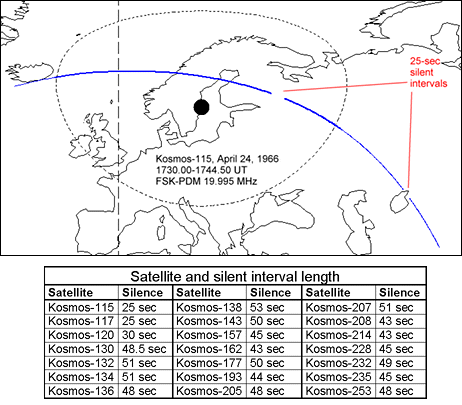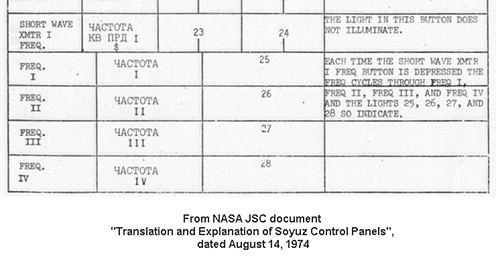 Switching
sequences
Switching
sequences Switching
sequences
Switching
sequencesThis phenomenon was dubbed by the "Kettering Group" and happened only during the last "radio-active" pass over Soviet Union each day. It affected only Zenit-2 type of reconnaissance satellites. It was last observed by myself from Kosmos-696 in 1974 - eight years after the first observation..
The silent interval varied from satellite to satellite, but was always constant for a particular satellite. The silent interval fell in the range 25-55 seconds. The period between the silent intervals varied and was sometimes as large as 6 minutes. A table showing some the silent period duration for a group of Zenit-2 satellites.
I have never found an
explanation
of this phenomenon and it is difficult to imagine one. I have toyed
with
idea that onboard power was needed for some urgent purpose and all
non-critical
loads were switched off, but what was the urgent purpose? Anyway, I
invite
ideas to solve this little mystery.
 Soviet
reconnaissance satellites of the Zenit-4MK "Germes" type are often
called
3rd generation high resolution reconnaissance mission. These satellites
were manoeuvrable and started flying regularly in 1970 after their
probable
introduction with Kosmos-317 in December 1969. This type of
satellite
was observed to transmit on 19.989 MHz. The signal on this frequency
cycled
back and forth between two adjacent frequencies about 1100 Hz apart.
The
cycling rate, i.e. the time it took to return to the initial frequency
was approximately 1.6 seconds. The cycling rate varied a little from
satellite
to satellite - something that probably was not intentional, but was
used
by amateur trackers to distinguish between satellites of the same time
in orbit simultaneously - which happened from time to time. So, the
signal
was simple simple frequency-shift-keying that has absolutely no
information
content. I have always wondered about this fact. Why bother to
transmit
this signal if nothing was transmitted? (The spectrogram on the right
shows
a segment of signals from Kosmos-364).
Soviet
reconnaissance satellites of the Zenit-4MK "Germes" type are often
called
3rd generation high resolution reconnaissance mission. These satellites
were manoeuvrable and started flying regularly in 1970 after their
probable
introduction with Kosmos-317 in December 1969. This type of
satellite
was observed to transmit on 19.989 MHz. The signal on this frequency
cycled
back and forth between two adjacent frequencies about 1100 Hz apart.
The
cycling rate, i.e. the time it took to return to the initial frequency
was approximately 1.6 seconds. The cycling rate varied a little from
satellite
to satellite - something that probably was not intentional, but was
used
by amateur trackers to distinguish between satellites of the same time
in orbit simultaneously - which happened from time to time. So, the
signal
was simple simple frequency-shift-keying that has absolutely no
information
content. I have always wondered about this fact. Why bother to
transmit
this signal if nothing was transmitted? (The spectrogram on the right
shows
a segment of signals from Kosmos-364).
Four year after the Kettering Group had discovered this signal we stumbled upon additional information about this strange signal, which we called "two-tone" in everyday exchanges. We discovered that the two-tone signals were present on two frequencies. A signal that sounded exactly like the signal on 19.989 MHz was detected on 39.978 MHz, i.e. on exactly double the frequency of the short-wave signals. What was this? An unattenuated unintended harmonic of the 19.989 MHz transmitter? Well, the signal on 39.978 MHz was very strong and not just a weak harmonic. Was it a separate transmission modulated by the same signal as that on 19.989 MHz. This controversy could have been cleared up if a recording of the 39.978 MHz signal had been preserved, but unfortunately no such recording exists. If the 39.978 MHz signal was a simple harmonic the frequency shift of the 39.978 MHz signal would have been double that of the 19.989 MHz. If not there could have been separate transmitters or two transmitters fed from the same basic oscillator but modulated after the carrier had been multiplied to the appropriate frequency. In either case the signals would have been coherent.
What possible use could
coherent
transmitters have? Perhaps as an ionosphere beacon system to
provide,
at a very low cost, an almost continuous system for monitoring electron
content and other parameters of the ionosphere. Is there any indication
in Soviet scientific publications of such data? Two-tone signals
continued
to be used until the early 1990's. I tracked my last signal on this
frequency
on 10 March 1991 when I picked up Kosmos-2136.
 "Telemetry
bursts" were observed on 20.008 MHz from Kosmos-140, -186/188 and
212/213
as described in another article
on this web site. The signal was switched "on" for 30 seconds and the
"off"
for 90 seconds. This pattern matches nicely the sequencer on the Soyuz
instrument panel that was capable of cycling between four frequencies
(see
figure on the right). The explanation reads:
"Telemetry
bursts" were observed on 20.008 MHz from Kosmos-140, -186/188 and
212/213
as described in another article
on this web site. The signal was switched "on" for 30 seconds and the
"off"
for 90 seconds. This pattern matches nicely the sequencer on the Soyuz
instrument panel that was capable of cycling between four frequencies
(see
figure on the right). The explanation reads:
"Each time the SHORT WAVE XMTR I FREQ button is depressed the frequency cycles through FREQ I, FREG II, FREQ III, and FREQ IV and the lights 25,26,27, and 28 so indicate".
The "30-90" pattern
certainly
indicates there were indeed four "slots". We know that the frequencies
15.008, 18.035 (later 18.060 MHz) and 20.008 MHz used by Soyuzes. One
of
these frequencies would would fit propagation conditions and "get
through"
to the receiver. But what was the fourth "slot"? Was it empty or was
there
another frequency used by Soyuz that we do not know of? Ideas are
herewith
invited!